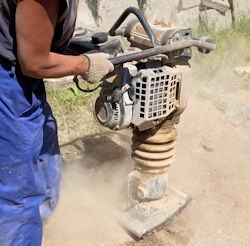Vibration
Both hand-held and stationary equipment can transmit harmful vibration that affects specific parts of the body (segmental vibration) as well as the entire body (whole-body vibration).
Segmental Vibration
Segmental vibration occurs when only part of the body, usually the hands and arms, is exposed to repeated vibration from tools or equipment. Common sources include hand-held power tools such as grinders, drills, chainsaws, and jackhammers. Over time, this type of vibration can cause hand-arm vibration syndrome (HAVS), Raynaud’s Syndrome ("white finger"), or peripheral neuropathy.
- Raynaud's Syndrome: Also called "white finger," this is a condition of the hands in which the blood vessels in the fingers collapse due to repeated exposure to vibration.
- Peripheral Neuropathy: Vibration may also cause damage to the peripheral nerves, and to the bones and joints causing aseptic necrosis, fatigue fractures, degenerative joint disease.
- Hand-Arm Vibration Syndrome (HAVS): This is a more advanced condition, and the entire hand or arm may be affected by exposure to vibration. Early signs of HAVS are infrequent feelings of numbness and/or tingling in the fingers, hands, or arms, or numbness and whiteness in the tip of the finger when exposed to cold.
Whole-Body Vibration (WBV)
Whole-body vibration occurs when a person’s entire body is exposed to repeated shaking or movement, usually while sitting or standing on a vibrating surface.
Whole Body Vibration
This often happens when operating heavy equipment, driving trucks, or riding in boats and other vehicles that produce constant vibration.
- Long-term exposure to whole-body vibration can cause injuries to the spine, muscles, and joints.
- It may may lead to lower back pain, muscle fatigue, and damage to spinal discs.
- Workers may also experience poor circulation, balance problems, and other physical strain.
Controls
Possible solutions include engineering controls to remove the vibration hazard and safe work practices to reduce exposure to existing or potential vibration. Examples include:
- Installing vehicle cab seats with vibration-damping components
- Using damping materials, felts, liquid mastics, and elastomeric damping sheets, to control vibrating panels of machine housings and guards
- Maintaining machines in proper working order to address unbalanced rotating parts or unsharpened cutting tools
- Replacing vibrating with non-vibrating tools
- Restricting the duration a worker uses a vibrating tool and equipment
- Training workers about the hazards and safe work practices of working with vibrating tools
Knowledge Check Choose the best answer for the question.
5-7. Peter frequently works with jack hammers; he has recently been feeling numbness and tingling in his fingers, hands, and arms. These may be early signs of _____.
You forgot to answer the question!

